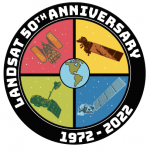On July 23, the Landsat program will celebrate 50 years of observing our ever-changing planet. Since 1972, this partnership between NASA and the U.S. Geological Survey has provided invaluable data about Earth's resources and environment. | | Make a STEM connection to this remote sensing milestone with STEM resources and activities.
| | Artists ages 14 and older from around the world are invited to capture stories of Earth science in action. Select one of three stories about how NASA Earth science satellite data helps communities address environmental challenges. Use your creativity to create a hand-drawn or digital art comic strip to illustrate the story. Artwork will be judged by a panel of comic artists, illustrators, astronauts, and scientists. Winning entries will be visible on NASA social media as well as SciArt Exchange digital and in-person display events. Top winners also will receive a personalized trophy and certificate.
Entries are due Aug. 13. Click here for contest details. | | Join NASA and fly your name through the clouds on its DC-8 aircraft. Outfitted with several instruments, NASA's DC-8 will gather data on ice crystal icing conditions in convective storms for NASA’s High Ice Water Content campaign.
Sign up and print your boarding pass before the last flight on July 27. | | STEM Webinars for Educators, Parents, Caregivers, and Students | | Audience: Educators, parents, and students in high school and college Webinar Date: July 21 at 2 p.m. EDT Join the NASA Ames Office of the Chief Scientist for the next webinar in the 2022 Summer Series. NASA is developing a new mission that will use a constellation or “swarm” of nine spacecraft to capture the first multiscale in-space measurements of fluctuations in the magnetic field and motions of the solar wind, known as solar wind turbulence. The HelioSwarm mission’s principal investigator Harlan Spence will discuss the science behind the mission and why it will provide unprecedented views into the nature of space plasma turbulence. Click here for the full list of upcoming seminars led by subject leaders spanning multiple subject areas including science, technology, and exploration. | | professional development hours. | | Audience: Public engagement and education institutions, such as museums, science centers, universities, youth service organizations, and other commercial and nonprofit groups Webinar Date: July 28 at 1 p.m. EDT Near-Earth objects are asteroids and comets that orbit the Sun like the planets, but their orbits can bring them into Earth’s neighborhood. The NASA Planetary Defense Program tracks these objects and develops mitigation strategies to protect life and property. Join NASA’s Office of STEM Engagement, Science Mission Directorate, and Office of Communications for an overview of NASA’s plans for a major planetary defense test this fall. Participants will learn about opportunities to use mission content in experiences designed to engage students, educators, families, and the public. | | The inaugural year of the NASA TechRise Student Challenge has been a great success, with 57 teams of students in grades 6-12 from across the U.S. working to design, develop, and prepare experiments to fly on a high-altitude balloon or suborbital rocket next year. Click here to see a glimpse of their progress and the amazing students who make up the NASA TechRise Community. With TechRise 2022-2023 expected to launch in early August, NASA invites educators and students to follow the progress of the NASA TechRise teams and brainstorm what kind of innovative experiments they would propose to NASA to help improve society. Sign up here to stay informed about future TechRise Challenges. | | Opportunities With Our Partners | | | | Workshop Dates: July 27-28 | | Application Deadline: Nov. 16 | |
Are you looking for NASA STEM materials to support your curriculum?
Find NASA science resources for your classroom. NASA Wavelength is a digital collection of Earth and space science resources for educators of all levels — from elementary to college, to out-of-school programs. https://science.nasa.gov/learners/wavelength
Check out the ‘Explore NASA Science’ website! Science starts with questions, leading to discoveries. Visit science.nasa.gov. To view the site in Spanish, visit ciencia.nasa.gov. | | Visit NASA STEM Engagement on the Web: | | | | | | |
|


















